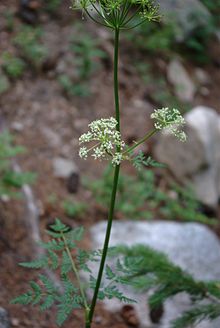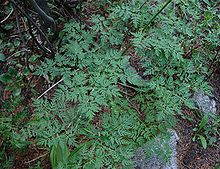- Osha
-
- For the European Agency, see European Agency for Safety and Health at Work, (EU-OSHA).
- For the U.S. government agency, see Occupational Safety and Health Administration.
Osha 
Scientific classification Kingdom: Plantae (unranked): Angiosperms (unranked): Eudicots (unranked): Asterids Order: Apiales Family: Apiaceae Genus: Ligusticum Species: L. porteri Binomial name Ligusticum porteri
Coult. & RoseOsha or oshá (Ligusticum porteri) is a perennial herb used for its medicinal and spiritual properties. Osha grows in parts of the Rocky Mountains and northern Mexico, especially in the southwestern United States.
Contents
Common names
Osha root, Porter's lovage, Porter's licorice-root, lovage, wild lovage, Porter's wild lovage, loveroot, Porter's ligusticum, bear medicine, bear root, Colorado cough root, Indian root, Indian parsley, wild parsley, mountain ginseng, mountain carrot, nipo, empress of the dark forest, chuchupate, chuchupati, chuchupaste, chuchupatle, guariaca, hierba del cochino or yerba de cochino, raíz del cochino, washí (tarahumara).
In the Jicarilla language, osha is called ha’ich’idéé. The White Mountain Apache call it '"Ha 'il chii' gah".
Distribution
Osha is strictly a mountain plant, and it is most commonly found in deep, moist soils rich in organic material. The plant requires partial shade. Osha is widely distributed from British Columbia south into Oregon and Washington State, and throughout the Rocky Mountains and the high mountains of New Mexico. It is most common in the upper limits of the subalpine zone, so in the southern part of its range, it grows at elevations from 7,000 feet to 10,000 feet (2100 m to 3000 m), while from Utah, Wyoming, and Montana northwards, it grows as low as 5,000 feet (1500 m).
Osha is dependent on mycorrhizal fungi, and attempts to artificially cultivate the plant outside of its habitat have not been successful. Cultivation of osha in areas where it naturally grows have been more successful.[1]
Identification
Osha has the typical appearance of members of the parsley family, with parsley-like leaves and umbels of white flowers. The bases of the leaves where they attach to the root crowns have a reddish tint which is unique, and the roots are fibrous, with a dark, chocolate-brown, wrinkled outer skin. When this skin is removed, the inner root tissue is fibrous and yellowish-white with an overpowering, pleasant "spicy celery" fragrance that resembles lovage (Levisticum officinale).
Osha roots have a collar of dead leaf material surrounding the root crowns which is hairlike in appearance. The roots dry very quickly and are very astringent when fresh, and can cause blistering of the mouth and mucous membranes in humans if ingested fresh. The dried roots do not have this astringent affect. Roots of older plants are far stronger and bitter than those of younger plants.[citation needed]
Osha plants form large clumps over time, and can grow to be very large. In areas of New Mexico, Colorado, and Utah, osha can reach heights of 6 to 7 feet and produce circular colonies with dozens of root crowns growing from a central root mass. Osha is best harvested in the afternoon as the plants are relished by bears, which are known to visit the plants during the morning.[citation needed]
Similar species
Osha grows in the same habitat in areas of the Mountain West of North America with poison hemlock and water hemlock, highly poisonous members of the same family. Osha particularly resembles poison hemlock but is easily distinguished from it by its "spicy celery" odor, hair-like material on osha root crowns, and dark chocolate-brown, wrinkled root skin. Hemlock roots are white and fleshy and thin-skinned; they are typically heavily branched rather than carrot-like, but this is not always the case. Poison hemlock roots have little or no odor; the plants themselves smell "musty" or "mousy" or rank. Osha leaves have an intense fragrance when bruised and are typically larger than those of poison hemlock. Most poison hemlock plants have purple blotches or shading on the lower stem if they are fairly mature, but again, this is not always the case. Unlike its poisonous cousins, osha does not tolerate overly moist soils (because it depends on mycorrhizal fungi) and is never found growing in standing water. Nevertheless there are areas where osha and poison hemlock can be found only a few feet from each other.[citation needed]
If the plant is growing near water in consistently moist soil, is tall (0.75–2m), has purple splotches on the main stem, and is heavily branched with small umbels of white flowers, it is probably poison hemlock and should be avoided. In any case, due to the high toxicity of poison hemlock, if a supposed osha plant cannot be positively identified, it must be discarded.
Coniine, the main poison in hemlock species, can be absorbed through the skin. People who have come into contact with these plants, including crushing the leaves to perform a "smell test", should wash their hands immediately and avoid touching their eyes or mouth.
Yarrow (Achillea millefolium, common yarrow, gordaldo, nosebleed plant, old man's pepper, sanguinary, milfoil, soldier's woundwort, thousand-leaf (as its binomial name affirms), or thousand-seal) also has many small white flowers in a cluster. However, yarrow has feathery leaves which are pinnately separated into small narrow segments.[2] Cow parsnip (Heracleum lanatum, Heracleum maximum, Indian celery, or pushki, sometimes considered a subspecies of Heracleum sphondylium, hogweed or eltrot) is also confused with osha and other plants with similar flower groupings. However, cow parsnip has large, broad leaves and an unpleasant odor.[3] SSK
Uses and toxicity
Osha root or Ligusticum wallichii (Ligusticum) root can be steeped in ethanol (whisky, vodka, etc.) for at least a month. The resulting tincture is an effective, albeit pungent, liniment for sore muscles that can be stored (in a cool place) indefinitely.[citation needed]
Osha root can "treat almost everything."[citation needed]
Osha has been clinically verifiedTemplate:By who or what to possess anti-viral properties (what and is very effective for treating cold and flu systems of the upper respiratory tract, and other viral infections of the respiratory system.[citation needed] The plant is also a powerful stimulant if consumed to excess.[citation needed] Osha root is typically chewed, then spit out after the medicinal components have been extracted by the chewing action.[citation needed] Osha root is also used internally in small amounts to treat fever, stomach ache, and heartburn. Osha root can be made into a poultice to treat brown recluse spider bites.[citation needed]
Osha has been sensationalized as an herbal remedy to the extent that the plants are seriously threatened in many areas due to overharvesting. Since osha defies cultivation outside of its habitat, commercial osha root is almost entirely harvested from wild stands of the plant.[citation needed]
Osha is commonly used by the Apaches and other native tribes. According to White Mountain Apache elders, they would use it as a snake and insect repellent: It has a strong smell. Apaches use this herb to aid in the curing of common colds, sore throats, cough, sinusitis, and other side effects of the winter season.[citation needed]
Cultural associations
In many Native American cultures osha is called "bear root" or "bear medicine", according to the ethnobotanist Shawn Sigstedt, who lived and studied with the Navajo. In Navajo folklore, a story is told of the brown bear's affinity for the Osha roots. The bear would eat the roots and the rub some of them over its fur. The Navajo credit the bear with leading them to powerful medicine.[4]
Name
The name porteri honors the botanist and Christian clergyman Thomas Conrad Porter (1822–1901)[5]
Osha has been said to mean "bear" in a Native American language[6] The original language is unknown.[7]
References
- ^ Edible and Medicinal Plants of the West, Gregory L. Tilford, ISBN 0-87842-359-1
- ^ "Yarrow Achillea millefolium". http://www.em.ca/garden/native/nat_Achillea%20millefolium.html. Retrieved 2008-08-03.
- ^ "Heracleum lanatum". University of Saskatchewan. http://www.usask.ca/agriculture/plantsci/classes/range/heracleum.html. Retrieved 2008-08-03.
- ^ Cowen, Ron. 1990. "Medicine on the wild side; animals may rely on a natural pharmacy". Science News. 138: 280-2; Terrell, Bernadette, and Anne Fennell. 2009. "Oshá (Bear Root): Ligusticum porteri J.M. Coult. & Rose var. porteri". Native Plants Journal.10 (2): 110-117.
- ^ Dodson, Carolyn; Dunmire, William W. 2007. Mountain Wildflowers of the Southern Rockies: Revealing Their Natural History. UNM Press, p. 78.
- ^ Bowen, Wm. F. "A Study of Osha Root and Its Volatile Oil." 1895. Proceedings of the Kansas Pharmaceutical Association, Sixteenth Annual Session. pp. 72–76.
- ^ Stewart, George R. 1970. American Place-Names: A Concise and Selective Dictionary for the Continental United States of America. Oxford University Press, p. 349.
External links
Categories:- Medicinal plants
- Ligusticum
Wikimedia Foundation. 2010.

